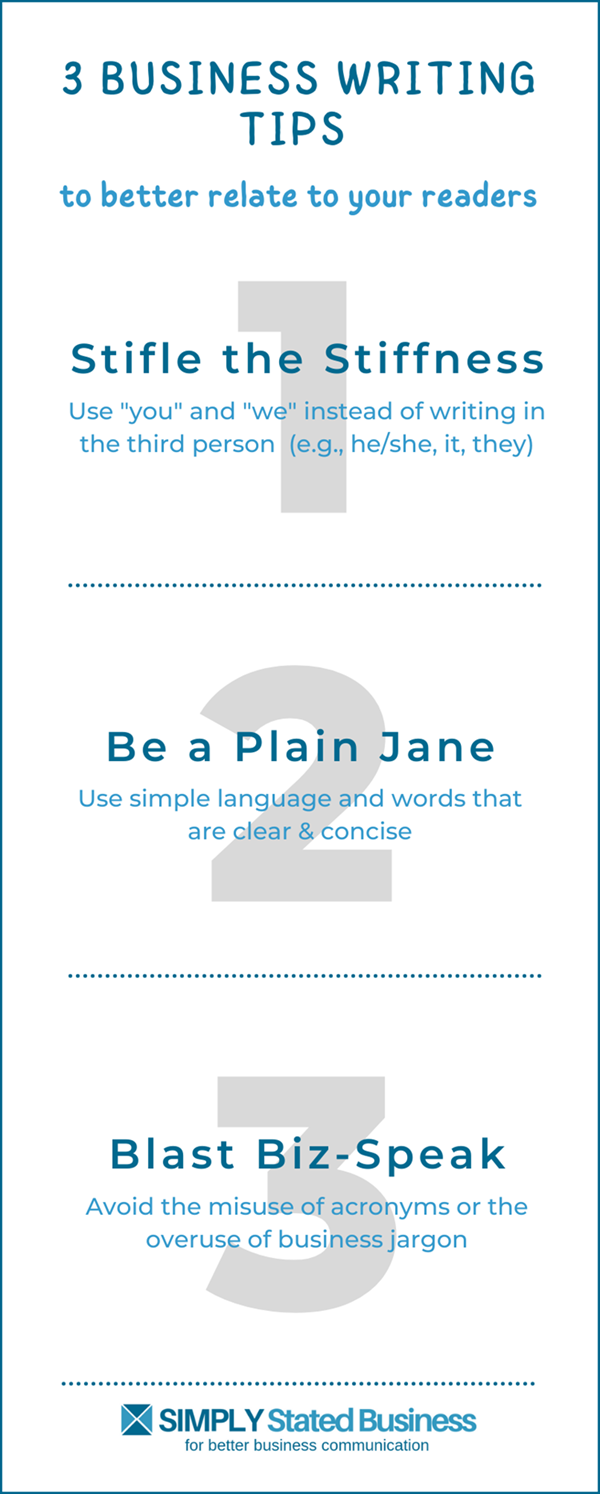 Have you read content so dry you wonder why your eyes aren’t choking? Cynics would say that’s the definition of business writing.
Have you read content so dry you wonder why your eyes aren’t choking? Cynics would say that’s the definition of business writing.
Creative business writing is not a contradiction of terms. If your content is gasping for breath, eliminate the obstruction.
Check your writing for these three common pitfalls.
3 Business Writing Pitfalls and How to Avoid Them
#1 – Sentences that require oxygen
You know the sentences I’m talking about, the kind that seem to just go on and on with no clear end in sight until you find yourself gasping for air (and you weren’t even reading it aloud) and if that’s not bad enough, by the time you get to the end of the sentence, you know the one that goes on and on, you forget what the subject was or at least you really don’t care anymore.
Run-on sentences squeeze the life out of your writing – and your reader.
How to avoid oxygen-deprived content
The secret to good writing is editing. Skip that step and accept the consequences. In business, that could be the loss of customers. Are you willing to take that risk?
Okay, enough lecturing.
The following are a few simple steps to spotting words gone wild.
- Read aloud (or use software that does that for you).
- Have someone else read the content.
- Use tools that offer word count for sentences.
On that last point, 20-25 words seems to be the consensus for maximum sentence length. But don’t obsess on the word count.
You should have a good mix of shorter and longer sentences. That is why I prefer using software that reads my content out loud. I’m better able to detect bumps in the word road to understanding.
A few editing tools that can help you with sentence length include the following.
- Microsoft Word Editor and Read Aloud feature
- Hemingway Editor app
- Grammarly
- Yoast SEO Readibility
 #2 – Business Writing that sounds like the building wrote it
#2 – Business Writing that sounds like the building wrote it
Just when workers settled into the comfort of remote work attire, many are being asked to return to the office.
Reading dry, boring business writing is like putting on a stiff business suit after a year of wearing sweats.
Corporate speak sneaks into business writing wearing different suits.
- Ramrod-stiff formality – e.g., XYZ Company has a tradition of excellence, offering clients experienced and expert financial counseling for over 100 years.
- Confusing language – including the misuse of acronyms and excessive or complex words.
- Overused phrases – the kind that hits everyone’s Most Hated list
How to humanize your business writing
Try the following tips to better relate to your readers.
Stifle Stiffness
The simplest tip for taking the stiffness out of your business writing is – be human. Instead of XYZ Company, use “we.” Instead of “clients,” use “you”. We offer you experienced and expert financial counseling.
Be a Plain Jane
Plain language sounds boring, doesn’t it? But consider this example (any government communication offers plenty of room for improvement).
In order to promulgate the terms of legislation, the government utilized multiple resources it had at its disposal.
Plain Jane alternative – The government published the legislation rules in various formats.
Jane doesn’t look so bad now, does she?
Download this Plain Jane alternatives to complex words.
Blast Biz-Speak
Acronyms are used so much in businesses that some workers no longer know the original, spelled-out version.
I’m all for simplifying the complex. But do not assume everyone knows what an acronym means. I guarantee you, someone will not know the meaning of even the most used acronym.
Spell out or explain acronyms the first time you use them in your writing.
Instead of: Good business writing can open the doors to JV and affiliate opportunities.
Use: Good business writing can open the doors to joint ventures (JV ) and affiliate opportunities.
Another pitfall is the abuse of business jargon. If you want scads of traffic to your blog post, write about business jargon. Ask readers for their most hated, overused phrase.
You can probably get away with the occasional phrase (depending on what it is). But beware of becoming the poster child for business clichés.
#3 – Being a passivist
The last of the business writing pitfalls is sneakier.You may use simple words but they lack authority. It’s like putting a silencer on your message.
Example: The sales information was presented by Michael Smith. (Passive voice in Bold)
Active voice: Michael Smith presented the sales information.
Why is the passive voice so prevalent?
- Are we passive by nature?
- Do we fear power words?
- Or do we have fear of commitment?
Using a passive voice in writing is a hard habit to break. I know. I work at it every day.
Take a Deep Breath
Take action against business writing that is on life support. Breathe life back into your content.
- Become a Ninja Word Wacker to run-on sentences
- Embrace the full beauty of clear, concise, and creative words
- Kick passive voice booty with power words
Your readers will thank you.
- How about you?
- Do you have pet peeves in writing?
- What tricks do you have for breathing life into your writing?
Note: This June 12, 2021 post updates the original Business Writing Pitfalls post that published August 3, 2011.
=====================
Helping you Keep it simple, clear & uniquely yours
====================



LOL! I want to be a Ninja Word Wacker! Love it, Cathy! I agree too – in your line of writing for businesses, and mine in writing for the medical world, it can be extremely difficult to bring creativity into the often dry content. Just following your few tips can at least make a big difference!
Thanks, Nicky-you are officially dubbed a Ninja Word Wacker.
One of the biggies in or industries (medical and insurance) is its status as the Masters of Acronyms. They have so many that often their original meaning is long forgotten. I sometimes feel like I’m reading Morse Code with all the acronyms. 🙂
Thanks for stopping by, Nicky!
I was going to make a short comment on this piece, but then I thought that would require me to use acronyms, which you feel are a problem; so, I just decided the best thing for me to do was just say- great post.
(panting for breath)
Roy-here’s one that always comes to mind with your comments – LOL! 😀
I went to school to become a journalist. We learned to write like you suggested. Then I grew up and forgot. Thanks for the reminder.
Hi Ann-I think it’s really easy to do that. I don’t know if it’s the casualness of blogging that leaks over to business writing. I know you hear write like you talk, but sometimes I don’t talk no good. 🙂
Thanks for stopping by and sharing your comment, Ann!
When I stared working on-line as a content creator I was indeed paid by the word, so I was all over the place with passive voice trying to raise those pesky word counts.
As a copywriter, I nowadays find myself going down the reverse route: trimming down on chunky content to make it as succinct and functional as possible.
Good article, by the way: I especially like how you go beyond pointing out these common issues and introduce quick fixes as well.
Hi Pedro-glad you came out of the dark side 🙂 Thank you for the kind words and sharing your comment.
My pet peeves with business writing (or any type of writing for that matter) are sentences that start with “It is” or “There are.” Rewriting to avoid those phrases almost always helps.
Hi Patricia. I have to admit, that’s not a pet peeve I’ve heard before. Now, I’m paranoid about the start of my sentences. 🙂
I’m all for helpful hints. Thanks for sharing yours.